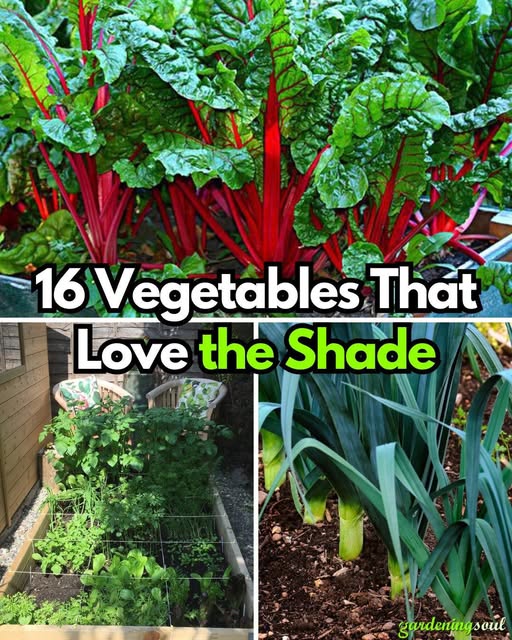By Linda Parker
March 30, 2025 – in Growing Vegetables
When most people imagine a thriving vegetable garden, they picture rows of plants basking in full, bright sunlight all day long. And it’s true—many vegetables such as tomatoes, peppers, and cucumbers crave long hours of direct sunlight. However, what if your garden is tucked into a shady corner of the yard, behind a fence, or under the canopy of trees?
Fortunately, not all vegetables require full sun to flourish. In fact, many leafy greens, root vegetables, and cool-weather crops thrive in partial shade, and some even prefer it. If your garden gets only morning sun or a few hours of filtered light, there’s still plenty you can grow.
In this expanded guide, you’ll discover 16 vegetables that grow well in shade, plus tips for designing a productive, low-light garden.
☀️ Understanding Light Levels in Your Garden
Before planting, take time to evaluate how much sunlight different parts of your garden receive. Light levels greatly influence plant growth and productivity.
- Full Sun: 6 to 8+ hours of direct sunlight daily
- Partial Shade: 3 to 6 hours of sunlight, often morning light
- Dappled Shade: Light filtered through trees or structures
- Full Shade: Less than 3 hours of direct sun
Most vegetables still need at least 3 hours of sunlight per day—ideally morning or early afternoon sun, which is less intense than late-day heat.
🥬 1. Spinach
Spinach is a cool-season green that thrives in shaded spots. Too much heat or direct sun can cause it to bolt and turn bitter.
- Light Needs: 3–5 hours or dappled light
- Planting Tips: Sow early in spring or late summer; thin seedlings to allow airflow
- Harvest: Baby leaves in 20 days, mature leaves in 30–45 days
- Bonus Tip: Harvest frequently to delay bolting
🥗 2. Lettuce
Lettuce loves cool weather and grows well in the shade, especially during the warmer months when too much sun leads to bitterness.
- Light Needs: 3–4 hours
- Soil: Moist, well-drained, rich in compost
- Harvest: 30–60 days depending on type
- Varieties to Try: Romaine, butterhead, loose-leaf
🌿 3. Arugula
Fast-growing and flavorful, arugula thrives in shaded areas and matures in under a month.
- Light Needs: 3–4 hours
- Tip: Harvest baby leaves for a mild flavor
- Bonus: Sow every 2 weeks for continuous harvests
🥬 4. Kale
Kale is a superfood that’s also super shade-tolerant. It stays sweet and tender longer in less sun.
- Light Needs: 4–5 hours
- Spacing: 12–18 inches apart
- Harvest: 50–70 days; pick outer leaves to keep growing
🌈 5. Swiss Chard
Chard offers bright color, high nutrition, and excellent shade tolerance. It keeps producing for months.
- Light Needs: 4–6 hours
- Soil: Fertile, well-drained
- Harvest: Outer leaves starting at 50 days
- Varieties: Rainbow chard, Fordhook Giant
🧄 6. Mustard Greens
These fast growers have a tangy bite that’s milder when grown in shade.
- Light Needs: 3–4 hours
- Spacing: 6 inches apart
- Harvest: Baby leaves in 25 days, full in 40
- Best Grown: Spring and fall
🥡 7. Bok Choy (Pak Choi)
A favorite in Asian cooking, bok choy is perfect for early spring or fall gardens with low light.
- Light Needs: 3–5 hours
- Spacing: 6–8 inches
- Harvest: 30–45 days
- Tip: Keep soil moist to prevent bolting
🥬 8. Cabbage
Cabbage grows dense, firm heads in cooler conditions. Shade helps avoid early flowering.
- Light Needs: 4–5 hours
- Spacing: 12–18 inches
- Harvest: 70–90 days
- Tip: Use floating row covers to prevent pests
🥦 9. Broccoli
Broccoli thrives with 4–6 hours of sun and appreciates cooler temps. The shade can enhance flavor and texture.
- Spacing: 18 inches apart
- Soil: Compost-rich and moist
- Harvest: 60–90 days; side shoots appear after cutting main head
🥬 10. Cauliflower
Cauliflower is a bit fussy but does well in shade. The curds remain tight and white when shielded from intense sun.
- Light Needs: 4–5 hours
- Spacing: 18–24 inches
- Tip: Tie outer leaves over heads to “self-blanch”
🌱 11. Peas
Peas grow vigorously in cool, partly shaded conditions—especially helpful in late spring.
- Light Needs: 4–6 hours
- Planting: Direct sow, 2 inches apart
- Harvest: 55–70 days
- Tip: Provide a trellis to increase airflow
🧃 12. Celery
Celery needs constant moisture and partial shade to prevent tough, stringy stalks.
- Light Needs: 3–5 hours
- Soil: Rich, moisture-retentive soil
- Harvest: 100–120 days
- Tip: Mulch heavily to retain soil moisture
🧅 13. Leeks
These onion relatives grow well with less light and develop thick, flavorful stalks.
- Light Needs: 3–5 hours
- Spacing: 6 inches
- Harvest: 90–120 days
- Tip: Mound soil up the stems for longer white shanks
🧄 14. Green Onions (Scallions)
Compact and productive, green onions are a top pick for containers or shady border gardens.
- Light Needs: 3–4 hours
- Harvest: 30–45 days
- Bonus: Regrow trimmed roots in water or soil
🌰 15. Radishes
Quick to grow and perfect for interplanting, radishes prefer cooler temperatures and partial shade.
- Light Needs: 4–5 hours
- Harvest: 25–35 days
- Tip: Don’t delay harvest—roots can get pithy
🍠 16. Beets
Both beet roots and greens are edible, and they grow well in partial shade. The roots mature slowly but are worth the wait.
- Light Needs: 3–5 hours
- Harvest: 50–70 days
- Tip: Thin early and often to encourage root development
🏡 Designing a Shade-Loving Vegetable Garden
If you’re working with a shaded garden, here are a few strategies to help you succeed:
1. Grow in Raised Beds
Shady areas often have compact or poor soil due to nearby trees or structures. Raised beds allow you to control soil quality and improve drainage.
2. Prioritize Leafy Greens
Leafy vegetables such as lettuce, spinach, and arugula don’t need as much sunlight to produce high yields. Focus on greens if your space is limited.
3. Use Reflective Mulch or Surfaces
Reflective materials like white stones, mirrors, or aluminum panels can bounce extra light onto plants, improving photosynthesis.
4. Choose Lighter Colored Containers
If you’re growing in pots, opt for light-colored containers—they reflect heat and prevent soil from overheating in warmer weather.
5. Interplant Wisely
Shade-tolerant vegetables can be interplanted between taller crops or under trellised plants to maximize space and light sharing.
🌿 Final Thoughts: A Productive Garden Without Full Sun
While a sun-drenched plot may offer more flexibility, a shaded garden can still be remarkably productive if you choose the right crops and understand your microclimate. Leafy greens, cool-season veggies, and root crops are your best friends in low-light environments.
With a bit of planning, compost-rich soil, and consistent care, you can turn your shady garden into a thriving source of fresh, flavorful vegetables—proving that sunshine isn’t the only path to harvest success.
So whether you’re gardening under trees, beside buildings, or on a north-facing balcony, don’t despair. Embrace the shade, plant smartly, and enjoy the bounty nature provides—sunlight or not.





